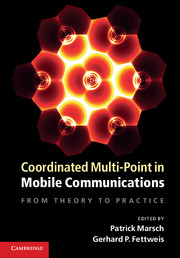Book contents
- Frontmatter
- Contents
- List of Contributors
- Acknowledgements
- List of Abbreviations
- Nomenclature and Notation
- Part I Motivation and Basics
- Part II Practical CoMP Schemes
- Part III Challenges Connected to CoMP
- Part IV Performance Assessment
- Part V Outlook and Conclusions
- 15 Outlook
- 16 Summary and Conclusions
- References
- Index
15 - Outlook
from Part V - Outlook and Conclusions
Published online by Cambridge University Press: 05 August 2012
- Frontmatter
- Contents
- List of Contributors
- Acknowledgements
- List of Abbreviations
- Nomenclature and Notation
- Part I Motivation and Basics
- Part II Practical CoMP Schemes
- Part III Challenges Connected to CoMP
- Part IV Performance Assessment
- Part V Outlook and Conclusions
- 15 Outlook
- 16 Summary and Conclusions
- References
- Index
Summary
In this chapter, we give an outlook onto some further issues connected to CoMP, where major research is still ongoing. In Section 15.1, it is shown that CoMP can also be used for purposes other than spectral efficiency and fairness increase, namely for the localization of terminals in cases where GPS is not available. Section 15.2 then discusses the usage of CoMP in conjunction with relaying, showing that both technologies can complement each other well in providing efficient and ubiquitous mobile broadband access. Section 15.3 discusses how the planning and optimization of future networks will be affected due to the introduction of CoMP, while Section 15.4 addresses one essential yet unanswered aspect of CoMP: How does CoMP perform in terms of energy efficiency?
Using CoMP for Terminal Localization
Location information about user equipments (UEs) is a valuable characteristic and can be exploited in various layers of mobile communications systems. At the application layer, the availability of location information provides new market opportunities by enabling location based services. In lower system layers, performance improvements can be achieved using location information for optimizing handover or radio resource management for example. Nowadays, an increasing number of UEs are equipped with global positioning system (GPS) chipsets, which allows location determination at the terminals themselves. Satellite based localization reaches its limits for instance in urban canyon environments or even indoors. However, these environments typically show high user densities.
Information
- Type
- Chapter
- Information
- Coordinated Multi-Point in Mobile CommunicationsFrom Theory to Practice, pp. 411 - 454Publisher: Cambridge University PressPrint publication year: 2011
